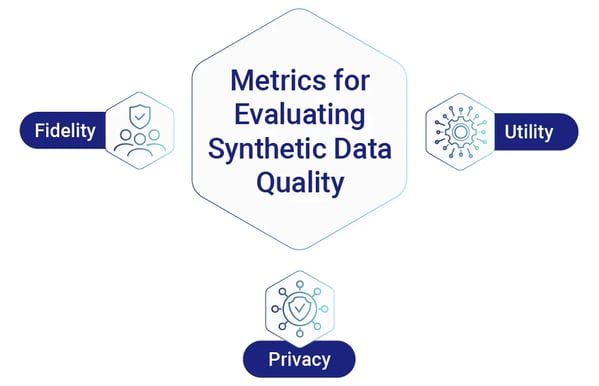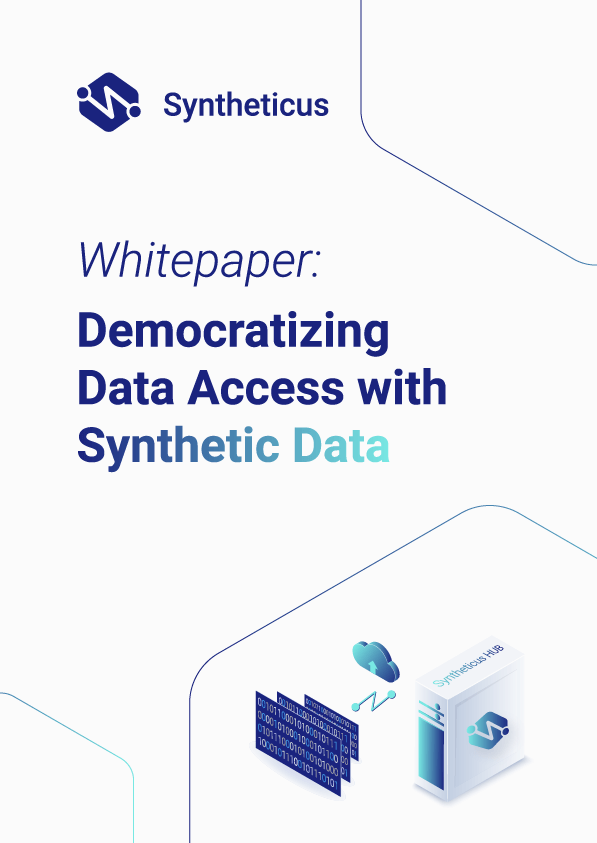How to evaluate synthetic data quality

Data is the backbone of any modern business, powering everything from analytics to decision-making. Unfortunately, the data collected and used by companies often comes with challenges — from accuracy and consistency issues to privacy and security concerns.
To address these issues, businesses are turning to synthetic data.
Synthetic data is a computer-generated substitute for real-world data that mimics the statistical properties of the original dataset while preserving privacy and security. It is a cost-effective and efficient solution that offers numerous benefits, including faster analysis times, greater control over the quality and format of the data, and increased security for sensitive data sources.
However, generating high-quality synthetic data can be a challenge on its own. The accuracy, bias, and security of synthetic data are all factors that must be carefully considered to ensure that it meets the needs of the organization.
This article will discuss the importance of data quality in synthetic data and how to ensure that your synthetic datasets are accurate, reliable, and up to industry standards.
Data quality basics
Data quality is the degree to which data meets the requirements of its intended purpose. The term refers to a dataset’s accuracy, completeness, validity, uniqueness, and consistency. In other words, it measures how well a dataset reflects reality and can be used to make informed decisions.
Data quality is especially important in the context of synthetic data. Synthetic data must not only replicate the statistical properties of its source dataset but also maintain accuracy and consistency over time to ensure that it remains useful for analysis and decision-making.
To achieve desired data quality level in synthetic datasets, organizations must adhere to various industry standards and best practices. These include ensuring the dataset is generated using an appropriate model and correctly configured parameters, validating the results against known values, and regularly testing for potential issues.
Benefits of high-quality synthetic data
The main advantages of synthetic data lie in its privacy and security benefits. By replacing sensitive information with secure computer-generated values, businesses can reduce the risk of data breaches and mitigate the privacy concerns of real-world data. Additionally, synthetic data can be generated quickly and cost-effectively, which is a great way to reduce the burden on internal resources.
However, the real value of synthetic data lies in its ability to provide accurate and reliable insights. High-quality synthetic data is used for various purposes, from training machine learning models and powering predictive analytics and simulations to providing insights into customer behavior and trends.
That said, to achieve meaningful results, the quality of synthetic data must be the top priority. Poorly generated synthetic data can introduce bias and inaccuracies that undermine the validity of the insights it generates, leading to poor decision-making and wasted resources.
The quality of generated data will depend on the quality of the data source and model used to generate it. The data source must be representative of real-world data, and the model must accurately fit the statistical properties of its source dataset.
The problem is, guaranteeing data quality is not always easy. It depends on the organization's specific use case and requirements and involves checking a variety of data attributes to ensure that the synthetic dataset meets industry standards. To simplify the process, companies turn to specialized synthetic data generation solutions that can guarantee consistent and accurate datasets.
Challenges of synthetic data generation
Despite all the advantages of synthetic data, there are still some challenges associated with its generation that can influence data quality. These include:
Accuracy degradation
While a synthetic dataset may look realistic and accurate, it will never be identical to real data. Therefore, there is no guarantee that the accuracy level will remain the same. This is especially true for high-dimensional datasets or datasets with complex relationships.
Synthetic data generative models look for common trends in the source data and use those patterns to generate synthetic data, which may result in missing potential anomalies that are present in the real data. This can lead to inaccurate results, create bias in the generated data, and ultimately affect the accuracy of any insights generated from it.
Bias and variable selection
Another important issue is the generation of biased datasets. Generating synthetic data involves developing a model trained on real-world data that may inherit and reflect potential biases in this data. If these biases are not addressed, the generated data will be skewed and could lead to inaccurate results.
To ensure data accuracy and fair use, organizations must pay attention to the variables they use when generating synthetic data. Choosing the wrong variables or failing to identify correlations between them can lead to oversimplified models and inaccurate synthetic datasets.
In addition, organizations should be aware of how changes to their source data can affect the generated synthetic data, as manipulating datasets to create fair synthetic datasets might still result in biased results and inaccurate data.
Dependency on the real data
Not surprisingly, the quality of the synthetic data heavily depends on the real data used to generate it. If the real dataset contains inaccuracies, errors, or missing values, the generated synthetic dataset will likely contain the same.
Furthermore, the accuracy of the generated data may suffer if it is based on outdated or incomplete real-world datasets. If there is not enough real data available for training the synthetic model, then the accuracy of the generated data can be compromised.
Finally, no matter how sophisticated the algorithms and models used to generate synthetic datasets are, they can still be susceptible to statistical noise, such as adversarial perturbations, which can cause their outputs to be inaccurate.
Practical limitations
Apart from accuracy and bias concerns, synthetic data generation is still somewhat limited by practical considerations. For instance, generating large datasets can take significant time and resources. This can be especially problematic for organizations that regularly generate new datasets to keep up with customer demands or changing market conditions.
Additionally, it may require a significant investment of computing power to generate large datasets with complex structures. The cost of such processing can be prohibitive for many organizations with limited budgets or computing power. Not to mention, the lack of skilled professionals who can effectively use synthetic data in their projects can also create a bottleneck for its adoption.
While there are certainly challenges to generating reliable and quality synthetic data, the benefits of using it can far outweigh these drawbacks. Potential issues can be addressed and mitigated with proper planning, collaboration, and continued investment in research and development. With the right approach and tools, organizations can generate synthetic datasets that are as accurate and useful as real-world data.
Strategies for ensuring the quality of synthetic data
By now, it should be clear that organizations that want to use synthetic data to power their operations must take certain measures to address the above challenges and ensure that their synthetic data is of high quality. In doing so, it's important to note that different synthetic data techniques have different levels of risk and accuracy and thus require different strategies.
Some best practices organizations should consider ensuring their generated data is of high quality include:
- Investment in data quality checks
- The use of multiple data sources
- Validation of generated synthetic data
- Regular reviews of synthetic datasets
- Implementation of model audit processes
Investment in data quality checks
Data quality checks mean using checks and balances to identify inconsistencies, inaccuracies, and errors in their datasets before they are used to generate synthetic data. This can be done by visually inspecting the source data and using automated tools to detect potential issues. By doing so, organizations can ensure that inaccuracies or errors are not passed along to the generated synthetic data.
The use of multiple data sources
Using multiple data sources can improve the accuracy of the generated synthetic datasets. This is because different data sources may provide additional context or detail that one source alone may not have. Additionally, combining multiple data sources can help reduce bias in the synthetic dataset that can be introduced when relying on a single data source.
Validation of generated synthetic data
To validate the quality of their synthetic datasets, organizations should use quality assurance practices to test the generated data for accuracy, consistency, and reliability. They can do it with automated tools that check for discrepancies between the generated and real-world datasets. Doing so can help organizations detect potential issues before deploying their synthetic datasets.
Regular reviews of synthetic datasets
Even after a synthetic dataset has been validated, organizations should still review it periodically to ensure accuracy and identify any issues that may have been caused by changes in the underlying source data, changes to the synthetic data generation process, or other unforeseen issues.
Implementation of model audit processes
Assessing the performance and efficacy of an AI model is an important part of ensuring the quality of synthetic data. The best way to do this is by using a model audit process that provides additional insight into the data, how it was processed, and how the generated synthetic dataset is being used. Implementing such processes can help organizations detect bias or errors in the generated synthetic data and take corrective actions as needed.
Metrics for evaluating quality in synthetic data sets
After an organization has taken the necessary measures to ensure its generated synthetic datasets are of high quality, it's important to evaluate the effectiveness of these measures. To do so, synthetic data is measured against three key dimensions: fidelity, utility, and privacy. Let's look at each one in more detail.

Metrics to understand fidelity
Any data science project must consider whether a certain sample population is relevant to the problem that they're solving. Similarly, to assess the relevance of the generated synthetic data, we must evaluate it in terms of fidelity compared to the original data.
The metrics used to measure fidelity include the following:
-
Statistical Similarity
-
Kolmogorov-Smirnov and Total Variation Distance Test
-
Category and Range Completeness
-
Boundary Preservation
-
Incomplete Data Similarity
-
Correlation and Contingency coefficient
Each of these metrics is used to compare the properties of the original data and generated synthetic dataset to measure how close they are. The higher the metric score, the higher the fidelity of the generated synthetic dataset.
Metrics to understand utility
Measuring the utility of synthetic data shows us how well the synthesized dataset fares with common data science problems when trained on several ML algorithms.
The following utility metrics aim to measure the performance of a generated dataset on downstream tasks:
-
Prediction score
-
Feature importance score
-
QScore
Higher scores for these metrics indicate that the generated synthetic dataset performs better on downstream tasks than the original dataset.
Metrics to understand privacy
Another method of evaluating the quality of synthetic data is by using privacy metrics. Privacy metrics measure how well the synthetic data conceals private information, such as identities or personal data. Before the generated synthetic data can be shared, we must know where the synthetic data stands compared to the original data regarding the extent of leaked information.
The following privacy metrics are used in this context:
-
Exact match score
-
Row Novelty
-
Correct Attribution Probability Coefficient
-
Inference
-
Singling-out
-
Linkability
The higher the score for these metrics, the more successful the generated synthetic dataset is at protecting sensitive information. When evaluating synthetic data's privacy properties, it's essential to consider both the utility and privacy scores together. A generated synthetic dataset with a high utility but low privacy score may be useful but can still lead to privacy violations.
Moreover, a tradeoff exists between fidelity, utility, and privacy. Data can’t be optimized for all three simultaneously - organizations must prioritize what is essential for each use case and manage expectations from the generated data.
Currently, there is no global standard to determine the appropriate quality regarding privacy, utility, or fidelity. The quality needs to be assessed on an individual use case basis to ensure that generated synthetic datasets are suitable for the intended purpose.
Final thoughts
As the use of synthetic data continues to grow, its impact will only become more pronounced in the coming years. With its potential to democratize access to data while minimizing risk, synthetic data will become a powerful tool in the hands of both data owners and data users within organizations. It will undercut the strength of proprietary datasets and create new opportunities for businesses to become more data-driven.
As the user of the synthetic data, it's essential to define the context of the use case and understand the quality of the generated data before deployment. Assessing the quality of synthetic data helps ensure that it is suitable for the desired application and does not violate data privacy regulations.
The Syntheticus platform deploys various metrics to evaluate the quality of synthetic data and is able to customize and add external metrics for further validation. This ensures that generated synthetic datasets are accurate and of the highest quality while protecting sensitive information from potential misuse or breach. To learn more about the Syntheticus platform and how it can help you generate high-quality synthetic data, visit Syntheticus.ai or get in touch with us today!
Tags:
Synthetic Data
March 3, 2023

